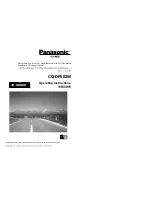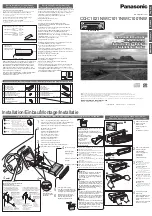
Power Tool Safety Rules
Read and understand all instructions. Failure to
follow all instructions listed below may result in
personal injury.
SAVE THESE INSTRUCTIONS
Safety Rules for Planer Attachment
Keep hands away from cutting area and bit. Keep
your second hand on finger grip. If both hands are
holding the tool, they cannot be cut by the bit. Hold the tool firmly to
prevent loss of control. Figures in this manual illustrate typical hand
support of the tool.
Advance the planer only in the direction indicated.
Use clamps or another practical way to secure and support the
workpiece to a stable platform. Holding the work by hand or against
your body leaves it unstable and may lead to loss of control.
Never hold piece being cut in your hands or across
your leg.
It is important to support the work
properly to minimize body exposure, bit binding, or loss of control.
Always use bits that are made specifically for this planer
attachment.
Do not run tool while carrying it at your side. Accidental contact
with the spinning bit could result in serious personal injury.
Know how to turn tool switch “OFF” in an emergency. If switch
cannot turn “OFF” the tool quickly, unplug the tool immediately.
Maintain a firm grip with both hands on the tool and position your
body and arm to allow you to resist KICKBACK FORCES. Kickback
forces can be controlled by the operator, if proper precautions are
taken.
When bit is binding, or when interrupting a cut for any reason, turn
off the tool and hold the tool motionless in the material until the
blade comes to a complete stop.
Kickback may occur.
Investigate and take corrective action to
eliminate the cause of bit binding. Wet lumber, green lumber or
pressure treated lumber and most plastics require special attention
during planing operation to prevent KICKBACK. Avoid cutting nails.
Inspect for and remove all nails from lumber before cutting/planing.
Wait for the cutter to stop before setting the tool down. An exposed
cutter may engage the surface leading to possible loss of control and
serious injury.
Do not use dull or damaged bit.
Assembly
Step One:
Removing housing cap from the Rotary Tool
Remove collet nut, then remove housing cap from your rotary tool and set
housing cap aside. The housing cap must be reinstalled when this
attachment is not used (1). Once housing cap has been removed,
reassemble collet nut.
Disconnect the plug from the power source before
making any assembly, adjustments or changing
accessories. Such preventive safety measures reduce the risk of
starting the tool accidentally.
MODEL PL400 PLANER ATTACHMENT
(For use with Dremel 400 Series XPR)
ADITAMENTO DE CEPILLADORA MODELO PL400
(Para usarse con la herramienta rotatoria Series 400
XPR de Dremel)
ACCESSOIRE DE RABOTAGE MODÈLE PL400
(À utiliser avec la série Dremel 400 XPR)
Operating/Safety Instructions
Instrucciones de funcionamiento
Notice d’utilisation
P.O. Box 1468
Racine, Wisconsin
1-800-437-3635
www.dremel.com
Read and understand these instructions and the
tool manual before using the Planer Attachment.
Wear eye protection.
Lea y entienda estas instrucciones y el manual de
la herramienta antes de utilizar el aditamento de
cepilladora. Lleve protección para los ojos.
Veuillez lire et comprendre ces instructions
ainsi que le mode d’emploi de l’outil avant
d’utiliser l’accessoire de rabotage. Portez une protection oculaire.
!
WARNING
AVERTISSEMENT
!
ADVERTENCIA
!
Dremel brand products are manufactured and sold by the
Dremel Division of Robert Bosch Tool Corporation
Les produits de marque Dremel sont fabriqués et commercialisés par la
Division Dremel de Robert Bosch Tool Corporation
Los productos de la marca Dremel son fabricados y vendidos por la
División Dremel de Robert Bosch Tool Corporation
OFF
(1)
!
WARNING
OFF
OFF
(2)
(4)
(3)
Align keys with corresponding keyways on tool.
Alinee las chavetas con los chaveteros correspondientes de la herramienta.
Mettez les ergots en face des rainures correspondantes de l’outil.
Insert this end into collet
Introduzca este extremo en el portaherramienta
Enfilez cette extrémité dans la douille
No shank visible
El vástago no debe ser visible
La queue ne doit pas être visible
Overthrow Nut
Tuerca de sobrerrecorrido
Bague filetée
(5)
(6)
(7)
Step Two:
Install Bit In Rotary Tool
Remove bit from plastic packaging tube.
The flutes on the bit are sharp and should be
handled with caution.
The bit has a long 1/8 inch shank on one end. Insert this end in the
collet until the shoulder of the bit bottoms against the collet (2).
Depress the shaft lock button and securely tighten the collet nut. No
shank should be visible (3).
Step Three:
Attaching Planer to your Rotary Tool
Slide the Planer Attachment over the cutting bit. Align the tip of the
cutting bit with the Bronze bushing in the planer end bearing. At the
same time, align the two keys with the keyways in the nose of the
Rotary Tool (4). When both features are aligned, the planer should
slip easily onto the rotary tool. Do not force the planer as this is a sign
of misalignment and damage could result. Once installed, slide the
Overthrow nut down and rotate until the threads engage with those on
the Rotary Tool. Continue to tighten the Overthrow nut until it is tight
against the Rotary Tool housing. Hand tighten only. The attachment
should be oriented on your Rotary Tool so that the speed control
switch in the Tool is easily accessible.
Operating Instructions
Planing Techniques
This planer is designed for two types of planing; straight planing, and 45
degree chamfering. In addition, the straight planing technique can be
used for limited shaping/carving.
Your rotary tool should be running at the highest speed setting before
beginning to plane and turned off after completing the job.
Primarily for use on wood or wood-like materials. Other materials may
cause blade to wear out prematurely. Not for used on metal or masonry.
Holding The Tool
A good, firm grip is essential for good control of the planer. One hand
should be placed on the rotary tool in the middle or rear of the tool, and
with the other hand, grip the finger grip with the thumb and index finger
(5). This will provide control and stability.
Directional Guide
Never feed the planer attachment in the direction
opposite of arrow “Loss of control may occur”. A
directional arrow on the attachment indicates the appropriate feed
direction.
For 90 degree planing, use the edge guide to keep planer square to the
work piece (6).
For 45 degree chamfer cuts, rotate the rotary tool/planer attachment
assembly until the 45 degree angled portion of the edge guide makes
flush contact with the side of the work piece (7).
Depth of Cut
Depth of cut is approximately 1/64 inch (.45mm). To assure that
planer is cutting to its maximum depth press firmly on the finger grip.
Also be sure to keep the planer level with the work surface. This is
done by using the hand which holds the rotary tool, and by assuring
that the edge guide remains flush to the side of the work surface.
To remove/plane more material, make multiple passes. Sometimes a
step or transition point is created while planing if the plane was not
DANGER
!
continued the full length of the material. This step or transition point
can be removed or blended with the adjacent material by using a
carving motion through the transition point. This technique comes
with practice, but involves a lighter pressing force on the finger grip
so as to plane less material away. At the same time longer strokes are
used to blend the adjacent planes together.
Cleaning
To avoid accidents, always disconnect tool from
the power supply before cleaning or performing
any maintenance. Clean planer if it should become clogged with dust
or wood chips. Use caution as cutting bit is sharp.
Certain cleaning agents and solvents damage
plastic parts. Some of these are: gasoline, carbon
tetrachloride, chlorinated cleaning solvents, ammonia and household
detergents that contain ammonia.
Always properly support and stabilize the work
piece to prevent accidents.
Planer Lubrication
Your planer comes with a pre-lubricated bearing. No lubrication is
required.
!
WARNING
!
WARNING
!
WARNING
!
CAUTION
!
WARNING
!
WARNING
Normas de seguridad para herramientas mecánicas
Lea y entienda todas las instrucciones. Si no sigue
todas las instrucciones que se indican a continua-
ción, el resultado podría ser lesiones corporales.
GUARDE ESTAS INSTRUCCIONES
Normas de seguridad para el aditamento de cepilladora
Mantenga las manos alejadas del área de corte y
de la broca. Mantenga la segunda mano sobre la
carcasa del motor. Si las dos manos están sujetando la herramienta, la broca
no puede cortarlas. Sujete firmemente la herramienta para evitar la pérdida
de control. Las figuras que aparecen en este manual ilustran el soporte
típico de la herramienta con las manos.
Haga avanzar la cepilladora solamente en el sentido indicado.
Use abrazaderas u otro modo práctico para sujetar firmemente y soportar
la pieza de trabajo a una plataforma estable. Si se sujeta la pieza de trabajo
con la mano o contra el cuerpo, se deja inestable dicha pieza y se podría
causar una pérdida de control.
No sujete nunca la pieza que esté cortando con las
manos o atravesada sobre una pierna. Es importante
soportar apropiadamente la pieza de trabajo para minimizar la exposición
del cuerpo, el atasco de la hoja o la pérdida de control.
Use siempre brocas que estén hechas específicamente para este
aditamento de cepilladora.
No tenga en marcha la herramienta mientras la lleva a su lado. Un
contacto accidental con la broca que gira podría causar lesiones corporales
graves.
Sepa cómo apagar la herramienta en una emergencia. Si el interruptor no
puede apagar rápidamente la herramienta, desenchúfela inmediatamente.
Mantenga un agarre firme con las dos manos sobre la herramienta y
posicione el cuerpo y el brazo para permitirle resistir las FUERZAS DE
RETROCESO. Las fuerzas de retroceso pueden ser controladas por el
operador, si se toman las precauciones adecuadas.
ADVERTENCIA
!
PELIGRO
!
!
WARNING
Feed Direction Arrow
Flecha de sentido de avance
Flèche indiquant le sens de l’avance
ADVERTENCIA
!
DM 2610924275 10-04 10/18/04 10:52 AM Page 1






















